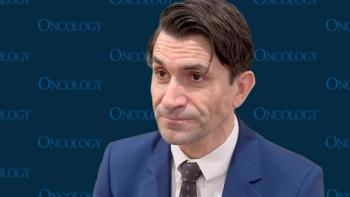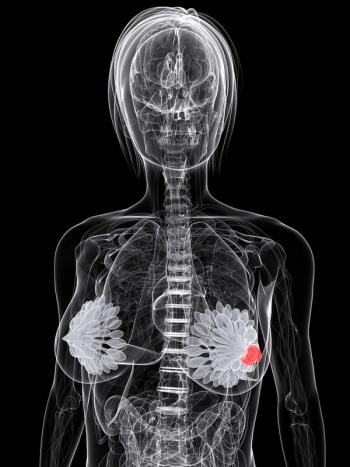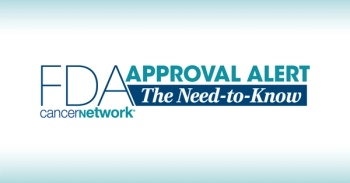
Elranatamab Triplet Induces Early and Deep Responses in Newly Diagnosed MM
The MagnetisMM-6 trial results showed that elranatamab plus daratumumab and lenalidomide yielded an ORR of 97.3% in transplant-ineligible multiple myeloma.
A combination of elranatamab-bcmm (Elrexfio), daratumumab (Darzalex), and lenalidomide (Revlimid) led to early and promising efficacy in patients with transplant-ineligible, newly diagnosed multiple myeloma, based on data from part 1, dose level G of the MagnetisMM-6 trial (NCT05623020) shared at the
At the data cutoff date of April 1, 2025, and a median follow-up of 7.9 months (range, 1.2-9.5), the confirmed investigator-assessed objective response rate (ORR) was 97.3% (95% CI, 85.8%-99.9%), the very good partial response or better rate was 94.6%, and the complete response (CR) or better rate was 27.0%. The partial response rate was 2.7%, and the median time to response was 1.5 months (range, 0.3-4.2).
“This trial showed early and promising efficacy, with 36 of 37 patients having responded, and responses are expected to deepen further with longer follow-up,” Meletios Athanasios Dimopoulos, MD, professor and chairman of the Department of Clinical Therapeutics at the National and Kapodistrian University of Athens School of Medicine in Greece. He also serves as dean of the medical school and rector of the university.
In dose level G of the trial, patients were given 76 mg of elranatamab every 4 weeks plus daratumumab at 1800 mg and lenalidomide at 25 mg. The primary end point was dose-limiting toxicities (DLTs) during the DLT observation period. Secondary end points included adverse effects (AEs) and laboratory abnormalities, ORR and CR, time to event end points, minimal residual disease negativity rate, pharmacokinetics, and immunogenicity.
To be eligible for part 1 of the trial, patients had to be 18 years or older with relapsed/refractory myeloma and/or transplant-ineligible, newly diagnosed disease; have measurable disease according to International Myeloma Working Group criteria; have ECOG performance status of 0 to 2; and have adequate liver and bone marrow function.
Thirty-seven patients were enrolled at dose level G and received at least 1 dose of elranatamab. Thirty-four patients were given the full regimen, and 3 patients only received elranatamab and discontinued treatment during the step-up period. At data cutoff, 86.5% of patients were still on treatment.
During cycle 0, step-up doses of elranatamab were given starting at 12 mg on day 1, 32 mg on day 4, and 76 mg on day 8. During cycles 1 and 2, elranatamab was given at 76 mg on day 1 followed by daratumumab at 1800 mg on days 1, 8, 15, and 22 and lenalidomide at 25 mg on days 1 to 21. For cycles 3 to 6, elranatamab was given at 76 mg on day 1, daratumumab at 1800 mg on days 1 and 15, and lenalidomide at 25 mg on days 1 to 21. For cycles 7 and beyond, elranatamab was given at 76 mg in combination with daratumumab on day 1 plus lenalidomide at 25 mg on days 1 to 21.
The median patient age was 75 years (range, 67-83), 62.2% of patients were women, 86.5% were White, and 59.5% had an ECOG performance status of 0. Revised International Staging System score by investigator included stage I (24.3%), II (54.1%), III (13.5%), or unknown (8.1%). Dimopoulos highlighted that 24.3% of patients were categorized as having frailty at baseline.
The most common any-grade treatment-emergent AEs included neutropenia (75.7%), cytokine release syndrome (CRS; 62.2%), pyrexia (37.8%), and anemia (35.1%). Grade 3 or higher AEs observed included neutropenia (73.0%), anemia (18.9%), thrombocytopenia (10.8%), and asthenia (10.8%).
Dimopoulos noted that all CRS events were grade 2 or lower, with 45.9% in grade 1 and 16.2% in grade 2. There was 1 case of grade 2 immune effector cell–associated neurotoxicity syndrome.
Infections of any grade occurred in 70.3% of patients, with the most frequently reported being upper respiratory tract infection (21.6%), Escherichia urinary tract infection (10.8%), and cytomegalovirus reactivation (10.8%). Grade 3/4 infections occurred in 18.9% of patients and included Escherichia urinary tract infection (2.7%), cytomegalovirus reactivation (2.7%), and pneumonia (2.7%).
Reference
Dimopoulos MA, Pour L, Grosicki S, et al. Elranatamab in combination with daratumumab and lenalidomide in patients with newly diagnosed multiple myeloma not eligible for transplant: initial results from MagnetisMM-6 part 1. Abstract presented at: European Hematology Association 2025 Congress; June 12-15, 2025; Milan, Italy. Abstract S206.
Newsletter
Stay up to date on recent advances in the multidisciplinary approach to cancer.
















































































